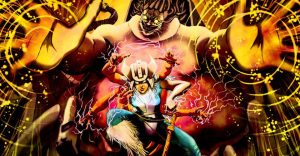Thor Is Secretly the God of [SPOILER], Not Thunder, Confirms Marvel

Marvel Comics reveals that the mighty Thor is not actually the God of Thunder, as everyone believed, but the much-more-impressive God of Storms. This intriguing development is part of Al Ewing and Javier Rodrìguez’s compelling exploration of Marvel’s cosmology that began in Defenders and continues in the sequel Defenders: Beyond, which also gave readers the origins of the Celestials and the whole Multiverse.
In Defenders, a group of heroes gathered by the magic of Doctor Strange to protect the universe from the time-traveling villain Carlo Zota. To do that, the team travels back to the previous incarnations of the Multiverse. Marvel’s cosmology, in fact, is based on the concept of cyclical destruction and rebirth, where every iteration of the Multiverse (or “cosmos”) is destined to be annihilated by some catastrophe and then reborn in a different, but similar, form. In issue #4 of the series, the Defenders’ journey brings them back to the Fourth Cosmos, which contains the archetypal ideas that are expressed in the current cosmos (the Eighth) in the form of heroes and villains, locked in endless battle.
In Defenders: Beyond #2, Ewing and Rodrìguez reveal the names of all the archetypes that appeared in the Fourth Cosmos, explaining what heroes and villains derive from them. Among them there is also Thor, who is called “Of-Storms“, and appears as a muscular man holding a hammer, whose head is a thunder-spitting cloud. It’s particularly interesting that Ewing did not choose “Of-Thunder” as the name of the character. Thor is known as the God of Thunder, but this archetype seems to contradict that, arguing he’s better understood through a larger and more diverse concept.
Thor’s hammer was originally powered by a primal creature called the God Tempest, trapped by Odin inside Mjolnir eons ago. This is what gave Mjolnir its amazing and unique abilities, and by extent also empowered Thor. This could be the first explanation, however, the son of Odin is also quite tempestuous himself, known for his volatile moods and for being a real force of nature once he unleashes his true power. A storm is something that contains a lot of elements, from thunder to rain to winds, so the name “Of-Storms” seems to point at Thor’s inner complexity, and that while he may command thunder and lightning, he’s at his core something more primal and complex.
The Fourth Cosmos was an incredibly important addition to Marvel’s mythology, because it showed the cosmic concepts that the heroes would later come to personify. Contrary to the other archetypes of Marvel heroes shown in the Fourth Cosmos, “Of-Storms” does not hint at something inherently heroic (for example, Daredevil’s archetype is called “Of-Justice“), because Thor is a god first, and a hero second. Just like a storm, a god’s actions can be beneficial or destructive, and Thor himself has done both terrible and glorious things in his past.


















